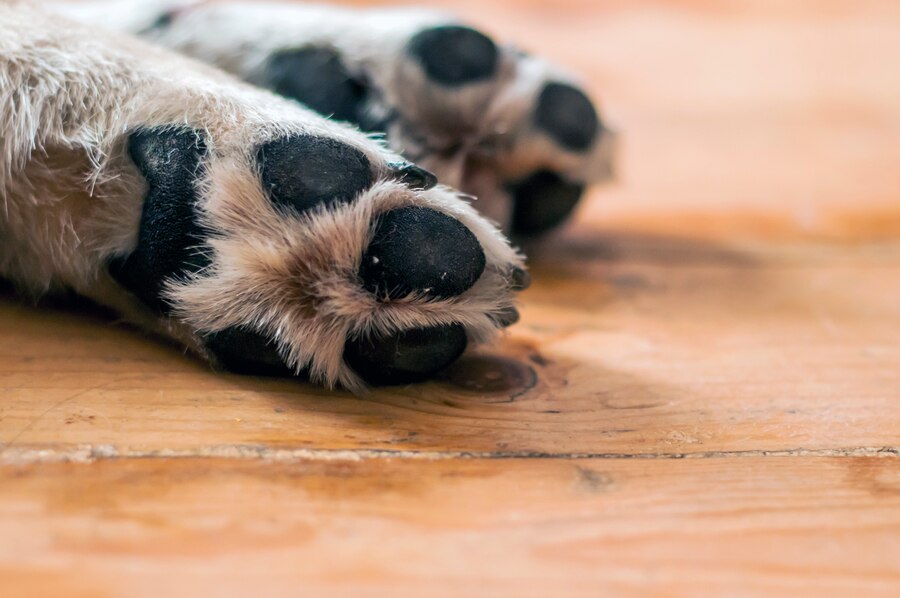Dogs paws are rough due to natural wear and tear from walking on various surfaces. Rough paw pads provide protection and grip.
Dogs’ paws endure constant contact with different surfaces. Roughness helps them navigate safely and avoid injuries. Walking on pavement, gravel, or dirt can cause natural abrasions. These rough textures provide better traction and protect sensitive tissues underneath. Sometimes, rough paws might signal a lack of moisture or exposure to harsh conditions.
Regularly checking your dog’s paws can help identify any unusual issues. Keeping the paw pads moisturized and clean can prevent excessive roughness. If you notice cracks or severe roughness, consult a vet. Proper care ensures your dog’s paws remain healthy and comfortable.
Common Causes
Frequent exposure to rough surfaces, extreme weather conditions, and lack of proper moisturization often leads to rough dog paws. Regular care and protection can help maintain your dog’s paw health.
Environmental Factors
Your dog’s paws can get rough from walking on rough surfaces. Hot pavement can burn their paws. Cold weather can make them dry and cracked. Salt used on icy roads can also hurt their paws. Grass and dirt can cause small cuts and scratches.
Genetic Predisposition
Some dogs are born with rough paws. Breeds like Greyhounds and Labradors often have tougher paws. This is due to their genetics. They need extra care to keep their paws soft.
Lack Of Moisture
Dry paws can make your dog’s paws rough. They need moisture to stay soft. Lack of water can make them dry. Using a paw balm can help keep them soft.
Signs Of Rough Paws
Dogs can develop rough paws from walking on hot surfaces, exposure to harsh weather, or frequent outdoor activities. Cracked, dry pads and redness are common signs of rough paws. Regularly moisturizing and protecting your dog’s paws can help maintain their health.
Cracks And Fissures
Cracks and fissures may appear on your dog’s paws. These can be painful and may bleed. Walking can become uncomfortable for your dog. Larger cracks can be a sign of serious issues. You should check your dog’s paws often.
Dry And Flaky Skin
Dry and flaky skin can make paws look white and scaly. This can cause discomfort to your dog. The skin may peel off in small pieces. You might see flakes around your home. Moisturizing the paws can help.
Sensitivity And Pain
Your dog might show signs of pain and sensitivity. They may limp or lick their paws often. This can be due to rough surfaces or extreme temperatures. Watch for these signs to keep your dog comfortable.
Health Issues
Allergies can make your dog’s paws rough. Dogs may scratch and lick their paws. This can cause the skin to become rough and irritated. Allergies may come from food, pollen, or chemicals. Keep an eye on your dog’s behavior. Notice if they lick or bite their paws often.
Infections can also affect your dog’s paws. Bacterial or fungal infections can cause roughness. These infections can make your dog feel itchy. Your dog may scratch and damage their paws. Make sure to check for redness and swelling. Clean your dog’s paws regularly.
Autoimmune disorders can cause rough paws in dogs. The immune system attacks healthy paw skin. This can lead to rough and cracked paws. Dogs with autoimmune disorders need special care. Consult your vet for the best treatment.
Environmental Hazards
Rough dog paws often result from environmental hazards like hot pavement, sharp objects, and harsh chemicals. Ensuring regular paw care and protection can help maintain their softness.
Hot Pavement
Walking on hot pavement can hurt your dog’s paws. The heat can cause burns and blisters. Dogs do not wear shoes like humans. They have no protection from the hot ground. Walking early in the morning or late in the evening can help. Avoid walking during the hottest parts of the day.
Cold And Ice
Cold weather can also be harsh on paws. Ice and snow can cause cracks and dryness. Walking on ice can be slippery and dangerous. Putting booties on your dog can help. Always check your dog’s paws after a walk in the snow.
Chemicals And Toxins
Chemicals like de-icers and fertilizers can harm paws. They can cause irritation and burns. Rinse your dog’s paws after a walk. This removes any harmful substances. Keeping your dog off treated lawns can also help.
Preventive Measures
Use paw wax to protect your dog’s paws. Booties are great for walks on rough surfaces. Keep your dog off hot pavement. Avoid icy roads and salted paths. Clean their paws after walks. This helps remove dirt and chemicals.
Check your dog’s paws daily. Look for cuts, scrapes, and foreign objects. Trim their nails to prevent injuries. Check between their toes for debris. Inspect paw pads for cracks and dryness. Early detection prevents bigger problems.
Keep your dog well-hydrated. Water helps maintain healthy paws. Feed a balanced diet rich in vitamins. Omega-3 fatty acids promote healthy skin. Consult your vet for dietary advice. Good nutrition supports paw health.
Home Remedies
Dogs’ paws can become rough due to factors like walking on hot pavement or exposure to cold weather. Regularly moisturizing with pet-safe balms can help keep their paws soft and healthy.
Aloe Vera
Aloe Vera is great for rough paws. It has soothing properties. Apply a small amount on your dog’s paws. Make sure it is absorbed well. Repeat daily for best results.
Coconut Oil
Coconut oil can soften rough paws. Rub a little on the paws daily. It also helps with healing. Use organic coconut oil for safety. Your dog will love the taste too.
Shea Butter
Shea Butter is very moisturizing. It helps with dry and rough paws. Massage a small amount on the paws. It absorbs quickly. Use it once daily for smooth paws.
When To See A Vet
Rough paws that don’t improve need attention. Your dog’s paws might be cracked or bleeding. This could cause your dog pain. Vet visits can help find the cause.
Severe cracking is a serious sign. Cracks can get infected. Your dog may limp or refuse to walk. A vet can provide treatments to heal the paws.
Infections need quick care. Look for redness, swelling, or pus. These are clear signs of infection. Your dog might lick their paws more. A vet can prescribe medicine to help.
Choosing The Right Products
Rough dog paws often result from walking on harsh surfaces or exposure to extreme weather. Selecting the right paw care products can help soothe and protect your furry friend’s feet, ensuring comfort and health.
Paw Balms
Paw balms are essential for dogs with rough paws. They help moisturize and soothe cracked skin. Apply a small amount on your dog’s paws. Use it regularly for best results. Check the ingredients before buying. Look for natural and safe components. Avoid products with harsh chemicals.
Moisturizing Sprays
Moisturizing sprays are another great option. They are easy to use and quickly absorbed. Spray directly on your dog’s paws. Rub gently to ensure it covers all areas. Choose sprays with natural oils. These provide better hydration and protection. Read reviews to find the best product for your pet.
Protective Booties
Booties protect your dog’s paws from rough surfaces. They are useful during walks on hot or cold pavements. Choose booties that fit well. They should be comfortable and secure. Check for durable materials. Good booties last longer and offer better protection. Your dog may need time to adjust to wearing them. Be patient and encouraging.
Another Post: Why Do Dogs Whimper in Their Sleep
FAQ
Why Are My Dog’s Paws Rough?
Rough paws can be due to walking on hard surfaces, weather conditions, or lack of moisture.
How Can I Soften My Dog’s Paws?
Use paw balms or moisturizers specifically designed for dogs to help soften and heal rough paws.
Is It Normal For Dogs To Have Rough Paws?
Yes, it is normal. Rough paws help provide traction and protect from various surfaces.
Conclusion
Caring for your dog’s paws is essential for their comfort and health. Regular checks and proper grooming help maintain soft paws. Use paw balms and ensure their environment is safe. By addressing rough paws, you ensure your furry friend stays happy and healthy.
Remember, a little attention goes a long way.

